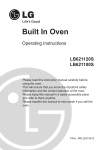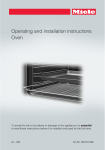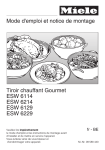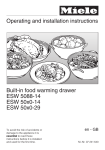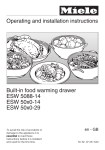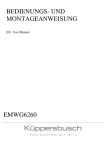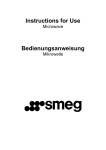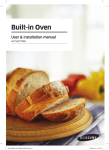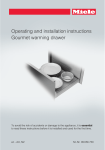Download Miele ESW 6229 Operating instructions
Transcript
Operating and installation instructions Food warming drawer To avoid the risk of accidents or damage to the appliance it is essential to read these instructions before it is installed and used for the first time. en - GB M.-Nr. 09 572 120 Contents Guide to the appliance . . . . . . . . . . . . . . . . . . . . . . . . . . . . . . . . . . . . . . . . . . . . . 3 ESW 6114 / ESW 6214 . . . . . . . . . . . . . . . . . . . . . . . . . . . . . . . . . . . . . . . . . . . . . . . 3 ESW 6129 / ESW 6229 . . . . . . . . . . . . . . . . . . . . . . . . . . . . . . . . . . . . . . . . . . . . . . . 4 Control panel . . . . . . . . . . . . . . . . . . . . . . . . . . . . . . . . . . . . . . . . . . . . . . . . . . . . . . 5 Accessories supplied . . . . . . . . . . . . . . . . . . . . . . . . . . . . . . . . . . . . . . . . . . . . . . . 6 Warning and Safety instructions . . . . . . . . . . . . . . . . . . . . . . . . . . . . . . . . . . . . . 7 Caring for the environment . . . . . . . . . . . . . . . . . . . . . . . . . . . . . . . . . . . . . . . . . 14 Before using for the first time. . . . . . . . . . . . . . . . . . . . . . . . . . . . . . . . . . . . . . . 15 Operation . . . . . . . . . . . . . . . . . . . . . . . . . . . . . . . . . . . . . . . . . . . . . . . . . . . . . . . 17 Functions . . . . . . . . . . . . . . . . . . . . . . . . . . . . . . . . . . . . . . . . . . . . . . . . . . . . . . . . 17 Temperature settings . . . . . . . . . . . . . . . . . . . . . . . . . . . . . . . . . . . . . . . . . . . . . . . 18 Duration . . . . . . . . . . . . . . . . . . . . . . . . . . . . . . . . . . . . . . . . . . . . . . . . . . . . . . . . . 18 Keeping food warm . . . . . . . . . . . . . . . . . . . . . . . . . . . . . . . . . . . . . . . . . . . . . . . 20 Warming crockery . . . . . . . . . . . . . . . . . . . . . . . . . . . . . . . . . . . . . . . . . . . . . . . . 23 Capacity. . . . . . . . . . . . . . . . . . . . . . . . . . . . . . . . . . . . . . . . . . . . . . . . . . . . . . . . . 24 ESW 6114 / ESW 6214 . . . . . . . . . . . . . . . . . . . . . . . . . . . . . . . . . . . . . . . . . . . 24 ESW 6129 / ESW 6229 . . . . . . . . . . . . . . . . . . . . . . . . . . . . . . . . . . . . . . . . . . . 25 Low temperature cooking . . . . . . . . . . . . . . . . . . . . . . . . . . . . . . . . . . . . . . . . . 26 Cooking table. . . . . . . . . . . . . . . . . . . . . . . . . . . . . . . . . . . . . . . . . . . . . . . . . . . . . 28 Other uses . . . . . . . . . . . . . . . . . . . . . . . . . . . . . . . . . . . . . . . . . . . . . . . . . . . . . . 31 Combination with CVA . . . . . . . . . . . . . . . . . . . . . . . . . . . . . . . . . . . . . . . . . . . . 32 Cleaning and care . . . . . . . . . . . . . . . . . . . . . . . . . . . . . . . . . . . . . . . . . . . . . . . . 33 Appliance front and interior . . . . . . . . . . . . . . . . . . . . . . . . . . . . . . . . . . . . . . . . . . 33 Anti-slip mat . . . . . . . . . . . . . . . . . . . . . . . . . . . . . . . . . . . . . . . . . . . . . . . . . . . . . . 34 Problem solving guide . . . . . . . . . . . . . . . . . . . . . . . . . . . . . . . . . . . . . . . . . . . . 35 Optional accessories . . . . . . . . . . . . . . . . . . . . . . . . . . . . . . . . . . . . . . . . . . . . . . 37 Safety instructions for installation . . . . . . . . . . . . . . . . . . . . . . . . . . . . . . . . . . . 38 Building-in dimensions . . . . . . . . . . . . . . . . . . . . . . . . . . . . . . . . . . . . . . . . . . . 39 ESW 6114 / ESW 6214 . . . . . . . . . . . . . . . . . . . . . . . . . . . . . . . . . . . . . . . . . . . . . . 39 ESW 6129 / ESW 6229 . . . . . . . . . . . . . . . . . . . . . . . . . . . . . . . . . . . . . . . . . . . . . . 42 Installing the appliance . . . . . . . . . . . . . . . . . . . . . . . . . . . . . . . . . . . . . . . . . . . . 45 Electrical connection . . . . . . . . . . . . . . . . . . . . . . . . . . . . . . . . . . . . . . . . . . . . . . 46 After sales service, data plate, guarantee . . . . . . . . . . . . . . . . . . . . . . . . . . . . . 48 2 Guide to the appliance ESW 6114 / ESW 6214 a Anti-slip mat b Control panel c Drawer with push to open and close mechanism The drawer can be opened and closed by pressing lightly in the middle of the drawer front. 3 Guide to the appliance ESW 6129 / ESW 6229 a Anti-slip mat b Control panel c Air vents d Rack 4 Guide to the appliance Control panel Sensors s On/Off sensor for the appliance X For selecting the function 6 For setting the temperature T For setting the duration Displays Functions: H For warming cups and glasses H For warming plates and dishes 2 For keeping food warm ¯ For low temperature cooking Temperature: ]^^^^ Duration: 1h 1 hour 2h 2 hours 3h 3 hours 4h 4 hours 5 Guide to the appliance Accessories supplied The accessories supplied with your appliance as well as a range of optional ones are available to order from Miele (see "Optional accessories"). Rack For increasing the loading area (ESW 6*29) Anti-slip mat For keeping crockery secure 6 Warning and Safety instructions This appliance complies with all statutory safety requirements. Inappropriate use can, however, lead to personal injury and damage to property. To avoid the risk of accidents and damage to the appliance, please read these instructions carefully before installation and before using it for the first time. They contain important notes on installation, safety, use and maintenance. Miele cannot be held liable for damage caused by non-compliance with these Warning and Safety instructions. Keep these instructions in a safe place and ensure that new users are familiar with the content. Pass them on to any future owner. 7 Warning and Safety instructions Correct application ~ The appliance is not designed for commercial use. It is intended for use in domestic households and similar working and residential environments. ~ The appliance is not intended for outdoor use. ~ It is intended for domestic use only as described in these operating instructions. Any other usage is not supported by the manufacturer and could be dangerous. ~ The appliance can only be used by people with reduced physical, sensory or mental capabilities, or lack of experience and knowledge, if they are supervised whilst using it, or have been shown how to use it in a safe way and understand the hazards involved. 8 Warning and Safety instructions Safety with children ~ Children under 8 years of age must be kept away from the appliance unless they are constantly supervised. ~ Children 8 years and older may only use the appliance unsupervised if they have been shown how to use it in a safe way and recognise and understand the consequences of incorrect operation. ~ Children must not be allowed to clean the appliance unsupervised. ~ Please supervise children in the vicinity of the appliance and do not let them play with it. ~ The appliance gets hot when in use and remains hot for quite a while after it has been switched off. Keep children well away from the appliance until it has cooled down and there is no danger of burning. ~ Danger of suffocation. Packaging, e.g. plastic wrappings, must be kept out of the reach of babies and children. Whilst playing, children could become entangled in packaging or pull it over their head and suffocate. 9 Warning and Safety instructions Technical safety ~ Installation, maintenance and repairs may only be carried out by a Miele authorised service technician. Installation, maintenance and repairs by unqualified persons could be dangerous. ~ A damaged appliance can be dangerous. Check the appliance for visible signs of damage. Do not use a damaged appliance. ~ The electrical safety of this appliance can only be guaranteed when correctly earthed. It is most important that this basic safety requirement is observed and regularly tested, and where there is any doubt, the household wiring system should be inspected by a qualified electrician. ~ To avoid the risk of damage to the appliance, make sure that the connection data (frequency and voltage) on the data plate corresponds to the household supply, before connecting the appliance to the mains supply. Consult a qualified electrician if in any doubt. ~ Do not connect the appliance to the mains electrical supply by a multi-socket adapter or extension lead. These are a fire hazard and do not guarantee the required safety of the appliance. ~ For safety reasons, this appliance may only be used after it has been built in. ~ This appliance must not be used in a non-stationary location (e.g. on a ship). 10 Warning and Safety instructions ~ Do not open the casing of the appliance. Tampering with electrical connections or components and mechanical parts is highly dangerous to the user and can cause operational faults. ~ While the appliance is under guarantee, repairs should only be undertaken by a service technician authorised by Miele. Otherwise the guarantee is invalidated. ~ Miele can only guarantee the safety of the appliance when original Miele replacement parts are used. Faulty components must only be replaced by genuine Miele original spare parts. ~ If the plug is removed from the connection cable or if the appliance is supplied without a plug, the appliance must be connected to the electrical supply by a suitably qualified electrician. ~ If the connection cable is damaged, it must be replaced by a suitably qualified electrician with a specialist connection cable of type H 05 VV-F ( (pvc insulated), available from Miele. ~ The appliance must be disconnected from the mains electricity supply during installation, maintenance and repair work. Ensure that power is not supplied to the appliance until after it has been installed or until any maintenance or repair work has been carried out. ~ In areas which may be subject to infestation by cockroaches or other vermin, pay particular attention to keeping the appliance and its surroundings clean at all times. Any damage caused by cockroaches or other vermin will not be covered by the guarantee. 11 Warning and Safety instructions Correct use ~ You could burn yourself on the hot drawer or crockery. Protect your hands with heat-resistant pot holders or gloves when handling hot dishes. Do not let them get wet or damp, as this causes heat to transfer through the material more quickly with the risk of scalding or burning yourself. ~ Do not store any plastic containers or inflammable objects in the warming drawer. They could melt or catch fire when the appliance is switched on, causing a fire hazard. ~ Due to the high temperatures radiated, objects left near the appliance when it is in use could catch fire. Do not use the appliance to heat up the room. ~ Never replace the anti-slip mat supplied with the appliance with paper kitchen towel or similar. ~ If you overload the drawer, or sit or lean on it, the telescopic runners will be damaged. The telescopic runners can support a maximum load of 25 kg. ~ If the appliance is installed behind a kitchen furniture door, it may only be used with the furniture door open. Only close the door if the appliance is switched off. ~ Do not heat up unopened tins or jars of food in the drawer, as pressure will build up in the tin or jar, causing it to explode. This could result in injury and scalding or damage. ~ The underside of the drawer gets hot when switched on. Be careful not to touch it when the drawer is open. 12 Warning and Safety instructions ~ Plastic and aluminium foil containers melt at high temperatures. Use only heat-resistant crockery made of glass, porcelain, etc. ~ Take care when opening and closing the loaded drawer, that liquids do not spill over and get through the vents. This can cause the appliance to short circuit. ~ The "Keep food warm" function is designed to keep hot food warm and not to warm up cold food. Ensure food is really hot when placed inside the warming drawer. ~ Bacteria can develop on the food if the temperature is too low. Make sure that you set a high enough temperature to keep food warm. Cleaning and care ~ Do not use a steam cleaning appliance to clean this appliance. The steam could reach electrical components and cause a short circuit. 13 Caring for the environment Disposal of the packing material Disposing of your old appliance The packaging is designed to protect the appliance from damage during transportation. The packaging materials used are selected from materials which are environmentally friendly for disposal and should be recycled. Electrical and electronic appliances often contain materials which, if handled or disposed of incorrectly, could be potentially hazardous to human health and to the environment. They are, however, essential for the correct functioning of your appliance. Please do not therefore dispose of it with your household waste. Recycling the packaging reduces the use of raw materials in the manufacturing process and also reduces the amount of waste in landfill sites. Ensure that any plastic wrappings, bags etc. are disposed of safely and kept out of the reach of babies and young children. Danger of suffocation. Please dispose of it at your local community waste collection / recycling centre or contact your dealer for advice. Please ensure that it presents no danger for children while being stored for disposal. 14 Before using for the first time Please stick the extra data plate for the appliance supplied with this documentation in the space provided in the "After sales service, data plate, guarantee" section of this booklet. Cleaning and heating up for the first time ^ Remove any protective foil. ^ Remove the anti-slip mat and, if applicable, the rack from the drawer, and wipe both with a sponge and a solution of hot water and a little washing-up liquid. Dry using a soft cloth. ^ Wipe the appliance inside and out with a damp cloth only, and then dry with a soft cloth. ^ Replace the anti-slip mat and the rack (if applicable) in the drawer. Then heat the empty drawer for at least two hours. ^ Switch the appliance on by touching the On/Off s sensor. ^ Touch the X sensor repeatedly until the s symbol lights up in the display. ^ Touch the 6 sensor repeatedly until the LED on the far right lights up. ^ Touch the T sensor repeatedly until 2h lights up. ^ Close the drawer. The drawer is fitted with a contact switch, which ensures that the heating element and fan in the appliance only work when the drawer is closed. 15 Before using for the first time The appliance will switch itself off automatically after 2 hours. The metal components have a protective coating which may give off a slight smell when heated up for the first time. The smell and any vapours will dissipate after a short time, and do not indicate a faulty connection or appliance. Ensure that the kitchen is well ventilated. 16 Operation Functions Use the X sensor to select the function you want. The applicable symbol lights up as follows: – H For warming cups and glasses – H For warming plates and dishes – 2 For keeping food warm – ¯ For low temperature cooking The last function selected is automatically activated the next time the drawer is switched on and this is shown in the display. The appliance has a fan which distributes the warm air evenly through the drawer. The fan runs continuously when the drawer is operating on the cups/glasses or plates/dishes function. It runs at intervals on the "Keep food warm" and "Low temperature cooking" functions. The appliance can be used to keep food warm at the same time as warming plates and dishes. Use the "Keep food warm" function for this. Take care. The plates and dishes will take longer to warm up, but can get very hot on this function. 17 Operation Temperature settings Each function has its own temperature range. The factory-set recommended temperatures are printed in bold. The temperature can be altered in 5° steps by touching the 6 sensor. The last temperature selected is automatically activated the next time the drawer is switched on, and this is shown in the display. (Exception: Low temperature cooking). Temperature display Temperature °C * H H 2 ¯ ]^^^^ 40 60 65 65 ^]^^^ 45 65 70 70 ^^]^^ 50 70 75 75 ^^^]^ 55 75 80 80 ^^^^] 60 80 85 85 * Approximate temperature values, measured in the middle of the drawer when empty Duration The appliance is set for continuous operation mode. (Exception: Low temperature cooking). A limited duration can be selected by touching the T sensor. One touch for 1 hour (1h), two touches for 2 hours (2h) etc, up to a maximum of 4 hours. Continuous operation is restored by touching the sensor a fifth time. Do not leave the drawer unattended for too long in continuous operation mode. Keeping food warm for a long time can result in it drying out or even self-igniting. Your appliance is fitted with a safety switch-off mechanism which switches the appliance off after a maximum of 12 hours' continuous operation. 18 Operation How to operate the drawer ^ Open the drawer. ^ Switch the appliance on by touching the On/Off s sensor. ^ Touch the X sensor repeatedly until the function required lights up in the display. ^ If you wish to alter the temperature, touch the 6 sensor until the LED for the temperature required lights up. ^ Touch the T sensor repeatedly until the duration (in hours) required lights up. ^ Close the drawer. The On/Off sensor s must be kept clean. Soiling or liquid on the sensor could cause it to fail to react or to switch on the appliance unintentionally. 19 Keeping food warm In order to ensure that the temperature does not drop below the minimum required for keeping food warm (65 °C), select the 2 function only. This function is for keeping food which has just been cooked warm, i.e. food that is still hot. It is not for reheating food that has gone cold. Procedure ^ Select the 2 function. ^ Select the duration required. ^ Pre-heat the drawer for 15 minutes to ensure that it has reached the required temperature. Whilst the appliance is heating up, place the empty dishes in the drawer. ^ Remove the pre-heated dishes from the drawer and fill them with the hot food. Use oven gloves to remove the dishes from the drawer. ^ Then place the dishes carefully in the drawer ensuring that any liquid does not spill over the sides. Tips – Place hot food in pre-heated dishes. To pre-heat the dishes, place them in the drawer whilst it is heating up. – Do not cover roast or fried food which you want to keep crisp. These types of food need to be kept warm at a higher temperature. – Cover food with a high moisture content and liquid and food which can develop a skin, with aluminium foil or a plate. – To avoid spillages, do not overfill dishes. 20 Keeping food warm – Freshly cooked food is hotter than food which is being kept warm. Serve food which is being kept warm on pre-heated plates. – Nutrients are lost when food is cooked and continue to diminish when food is kept warm. The longer food is kept warm for, the greater the loss of nutrients. – We do not recommend that food is kept warm for a long period of time, as it will continue to cook. – Do not slam the drawer open or shut. Liquids could spill over and get into the vents. – Food may cool down if the drawer is opened and shut too often. 21 Keeping food warm Settings Food Container Cover the container? Temperature for the 2 setting Position in drawer Floor Rack* x Steak (rare) Plate no ]^^^^ x Bake / gratin Shallow dish yes ^^^]^ x Roast meat Plate yes ^^]^^ x Casserole Dish yes ^^^]^ x Fish fingers Pan no ^^^^] x Meat in a sauce Dish yes ^^^]^ x Vegetables in a sauce Dish yes ^^^]^ x Goulash Dish yes ^^^]^ x Mashed potato Dish yes ^^]^^ x Plated meal Plate yes ^^^]^ x Plate / dish yes ^^]^^ x Breaded escalope Pan no ^^^^] x Pancakes/ potato pancakes Plate no ^^^^] x Pizza Plate no ^^^^] x Baked potatoes / New potatoes x Boiled potatoes Dish yes ^^^]^ x Gravy Dish yes ^^^]^ x Strudel Plate no ^^^]^ x To warm bread - no ]^^^^ x x To warm rolls - no ]^^^^ x x * Depending on model 22 Warming crockery – Distribute the crockery over the whole area of the drawer. Stacks of plates heat up more slowly than individual pieces of crockery. If large stacks of plates are unavoidable, place them at the front of the drawer. Use the rack (depending on model). – Do not place large serving dishes right up against the vents. They will cover the warm air outlets, and the crockery will not heat up evenly. – For cups and glasses, only select the H function to ensure that the maximum temperature (60°C) is not exceeded. – Heated crockery cools down very quickly. Do not remove it from the drawer until just before you need it. Heating up times Various factors will affect the heating up times: – The material and thickness of the crockery – The amount of crockery – How the crockery is arranged – The temperature setting. It is therefore not possible to state precise times. However, the following information can be used as a guide: On the H setting, it takes approx. – 30– 35 minutes for 6 place settings to heat up evenly. – 40– 45 minutes for 12 place settings to heat up evenly. – As you use the drawer, you will get to know which setting suits your own needs best. 23 Warming crockery Capacity The quantity that can be loaded will depend to a great extent on the size and weight of your crockery. Do not overload the drawer. The maximum load bearing capacity of the drawer is 25 kg. ESW 6114 / ESW 6214 The loading examples shown here are suggestions only. – 6 place settings: 6 dinner plates 6 soup bowls 6 dessert plates 1 oval serving dish 1 serving dish 1 serving dish C 26 cm C 23 cm C 19 cm 32 cm C 16 cm C 13 cm or alternatively: 24 – 12 dinner plates C 26 cm – 18 soup bowls C 23 cm – 16 soup cups C 10 cm – 6 dinner plates 6 soup bowls C 26 cm C 23 cm – 6 pizza plates C 36 cm – 72 espresso cups C 5.9 cm – 30 cappuccino cups C 8.8 cm – 30 punch glasses C 6.7 cm / 8 cm high Warming crockery ESW 6129 / ESW 6229 The loading examples shown here are suggestions only. – 12 place settings: 12 dinner plates 12 soup bowls 12 dessert plates 1 oval serving dish 1 serving dish 1 serving dish 1 serving dish C 26 cm C 23 cm C 19 cm 32 cm C 19 cm C 16 cm C 13 cm or alternatively: – 40 dinner plates C 26 cm – 60 soup bowls C 23 cm – 45 soup cups C 10 cm – 20 dinner plates 20 soup bowls C 26 cm C 23 cm – 20 pizza plates C 36 cm – 142 espresso cups C 5.9 cm – 90 cappuccino cups C 8.8 cm – 30 punch glasses C 6.7 cm / 8 cm high You can increase the load area by using the rack supplied with the appliance. Position the rack to suit. With two racks you can increase the load area even more by placing one rack on the left and the other on the right. Another rack can be obtained from Miele or from your Miele dealer (see "Optional accessories"). 25 Low temperature cooking With low temperature cooking meat is cooked at a low temperature over a long period of time. Using this method, meat loses less liquid as it is cooked gently and so remains succulent and tender. This cooking method is particularly suitable for large and tender pieces of meat. The quality of the meat is of vital importance for a good result. For precision we recommend using a proprietary food thermometer to monitor the core temperature. Do not use the food probe from a Miele steam combi oven or a Miele oven in the food warming drawer. Core temperature Food can be cooked to a core temperature of up to 70 °C in the food warming drawer. Meat which needs to be cooked to a core temperature higher than 70 °C is not suitable for cooking in the food warming drawer. The core temperature reading gives information about the degree of cooking in the middle of a piece of meat. The lower the core temperature, the less cooked the meat is in the middle: 45-50 °C = rare 55-60 °C = medium 65 °C = well done Cooking duration The cooking duration depends on the size of the individual pieces of meat, and can be between 1 and 6 hours. Add 15 minutes heating-up time to the temperature selected. Example: selected duration 1h, actual operating time 1 hour 15 minutes. Notes on low temperature cooking – The meat should have been hung for best flavour. – The quality of the meat is of vital importance for a good result. 26 Low temperature cooking – The meat must be at room temperature. Remove it from the refrigerator approx. 1 hour before preparation. – Sear the meat on all sides over a high heat on the hob. Procedure ^ Select the ¯ low temperature cooking function. The appliance will pre-heat automatically for 15 minutes and then operate at the pre-set temperature and duration, e.g. at 85° C and 4h (Medium sirloin joint setting, 1 kg, approx. 3 cm thick). ^ While the appliance is heating up, sear the meat on all sides over a high heat on the hob. ^ Put it in a heat-proof dish. ^ Push the food thermometer into the meat so that the tip is in the centre. Make sure that it does not come into contact with bones or layers of fat as these can cause a false reading. ^ Place the dish in the drawer. If you wish to cook on a different setting, please see the table on the following pages. ^ Select the ¯ low temperature cooking function. ^ Select the temperature required. ^ Select the duration required. Tips – Meat can be carved straight from the oven. It does not need to rest. – Due to the low cooking and core temperatures, meat can be kept warm quite safely in the appliance until it is served. This will not affect results in any way. – Serve the meat on pre-heated plates to stop it cooling too quickly. 27 Low temperature cooking Cooking table Type of meat Searing time Core temperature* °C Cooking time in minutes Temperature for the ¯ setting Beef Fillet approx. 1200 g 4–6 mins 6–8 mins 8 mins 45–50 55–60 65 105–135 160–190 195–225 ^]^^^ ^^^]^ ^^^^] Fillet approx. 600 g 4–6 mins 6–8 mins 8 mins 45–50 55–60 65 90–120 130–155 160–190 ^]^^^ ^^^]^ ^^^^] Medallions 3-4 cm thick 1 min per side 1–2 mins per side 2 mins per side 45–50 55–60 65 40–50 60–80 90–110 ^]^^^ ^^^]^ ^^^^] Sirloin joint approx. 400 g 4–6 mins 6 mins 8 mins 45–50 55–60 65 90–120 120–145 145–175 ^]^^^ ^^^]^ ^^^^] Sirloin joint approx. 600 g 4 mins 6–8 mins 8 mins 45–50 55–60 65 115–135 150–180 225–255 ^]^^^ ^^^]^ ^^^^] Sirloin joint approx.1.5 kg 8 mins 8–10 mins 10–12 mins 45–50 55–60 65 120–150 250–280 300–330 ^]^^^ ^^^]^ ^^^^] Rump steak approx.180 g 1 min per side 1–2 mins per side 2 mins per side 45–50 55–60 65 50–60 80–90 120–140 ^]^^^ ^^^]^ ^^^^] Fillet approx. 1200 g 5 mins 6 mins 6–7 mins 45–50 55–60 65 115–145 150–180 155–185 ^]^^^ ^^^]^ ^^^^] Fillet approx. 600 g 4–6 mins 6 mins 6–8 mins 45–50 55–60 65 75–95 90–120 125–155 ^]^^^ ^^^]^ ^^^^] Medallions 3-4 cm thick 1 min per side 1–2 mins per side 2 mins per side 45–50 55–60 65 40–50 60–80 90–110 ^]^^^ ^^^]^ ^^^^] Steak approx. 160 g 2 cm thick 1 min per side 1–2 mins per side 2 mins per side 45–50 55–60 65 35–50 60–80 75–90 ^]^^^ ^^^]^ ^^^^] Veal * 45-50 °C rare / 55-60 °C medium / 65 °C well-done 28 Low temperature cooking Type of meat Searing time Core temperature* °C Cooking time in minutes Temperature for the ¯ setting Pork Fillet approx. 350 g 5–6 mins 60 65 90–110 120–140 ^^^]^ Boned gammon approx. 700 g 6–8 mins 65 180–200 ^^^^] Boned gammon approx. 1.5 kg 8 mins 65 195–225 ^^^^] Pork loin approx. 1.5 kg 8–10 mins 65 210–240 ^^^^] Pork loin approx. 700 g 6–8 mins 65 180–210 ^^^^] Medallions approx. 4 cm thick 2 mins per side 2–3 mins per side 60 65 75–95 100–120 ^^^]^ Roulades approx. 150 g ½ cm thick 4–6 mins 65 150–180 ^^^^] Spare ribs 4–6 mins per side 65 165–195 ^^^^] Duck breast approx. 350 g 5–6 mins 65 70 45–65 80–95 ^^^]^ ^^^^] Chicken breast approx. 160 g 2-3 mins per side 70 45–60 ^^^^] Poularde breast approx. 250 g 2-3 mins per side 70 60–80 ^^^^] Turkey breast approx. 800 g 6–8 mins 70 150–180 ^^^^] Poultry * Pork = 60 °C medium / 65 °C well done Duck breast = 65 °C medium / 70 °C well done 29 Low temperature cooking Type of meat Searing time Core temperature * °C Cooking time in minutes Temperature for the ¯ setting Lamb Rack of lamb approx. 170 g 3 mins 4 mins 60 65 90–100 110–130 ^^^]^ ^^^^] Rack of lamb approx. 400 g 3–4 mins 4–6 mins 60 65 100–130 120–150 ^^^]^ ^^^^] Saddle of lamb off the bone (approx. 600 g) 4 mins 6 mins 60 65 90–120 130–160 ^^^]^ ^^^^] Boned leg of lamb approx. 1.2 kg 8–10 mins 65 330–360 ^^^]^ Venison medallions 3–4 cm thick 1–2 mins per side 2 mins per side 60 65 80–100 110–140 ^^^^] Saddle of venison off the bone approx. 800 g 4–5 mins 6–8 mins 60 65 135–150 165–180 ^^^^] Saddle of roebuck off the bone approx. 800 g 4 mins 6 mins 60 65 120–135 150–165 ^^^^] Haunch of hare approx. 250 g 5–7 mins 65 210–230 ^^^^] Roast wild boar approx. 600 g 6–8 mins 70 190–220 ^^^^] Game * Lamb = 60 °C medium / 65 °C well done Game = 60 °C medium / 65 °C well done / 70 °C well done 30 Other uses Type of food Container Cover the Temperature Temperature for the container? for the H setting 2 setting Position in drawer Floor Duration in hours: min Rack* Defrosting berries Bowl / dish no ]^^^^ x Dissolving gelatine Bowl no ^^^^] x Proving dough Bowl Yes, with plate ]^^^^ x 0:30 Making yoghurt Yoghurt jars with lids - ^]^^^ x 5:00 0:50 x 0:15 Yes, with lid ^^^^] x x 0:40 Bowl no ^^^^] x x 0:20 Defrosting Bowl frozen vegetables no ^^]^^ x Dish Rice pudding (to finish off the cooking process) Melt chocolate 1:00 * Depending on model 31 Combination with CVA The warming drawer can be set to come on automatically before your Miele coffee machine to ensure your cups are the perfect temperature for your first cup of the day. Please note that in coffee mode: – The Cups/Glasses function cannot be altered – The duration cannot be altered. – The safety switch-off mechanism is deactivated. Activating coffee mode Coffee mode can only be activated when the warming drawer is switched off. ^ Touch the T sensor. ^ Then touch the On/Off s sensor. ^ Continue to touch both sensors until both the 1h and 4h symbols in the time display and the H symbol light up simultaneously. Deactivating CVA mode ^ Touch the T sensor. ^ Then touch the On/Off s sensor at the same time. ^ Continue to touch both sensors until all symbols have gone out. 32 Cleaning and care ,Danger of injury. Do not use a steam cleaning appliance to clean this appliance. The steam could reach electrical components and cause a short circuit. Danger of damage. Unsuitable cleaning agents can damage the surfaces of the appliance. Only use domestic washing-up liquid to clean the appliance. Clean and dry the entire appliance after each use. Allow the appliance to cool down to a safe temperature before cleaning. Appliance front and interior Remove any soiling immediately. If this is not done, it might become impossible to remove and could cause the surfaces to alter or discolour. Clean all surfaces with a clean sponge and a solution of hot water and washing-up liquid. Then dry with a soft cloth. A clean, damp microfibre E-cloth without cleaning agent can also be used. All surfaces are susceptible to scratching. Scratches on glass surfaces could even cause a breakage. Contact with unsuitable cleaning agents can alter or discolour the surfaces. The On/Off sensor s must be kept clean. Soiling or liquid on the sensor could cause it to fail to react or to switch on the appliance unintentionally. 33 Cleaning and care To avoid damaging the surfaces of your appliance, do not use: – cleaning agents containing soda, ammonia, acids or chlorides, – cleaning agents containing descaling agents, – abrasive cleaning agents, e.g. powder cleaners and cream cleaners, – solvent-based cleaning agents, – stainless steel cleaning agents, – dishwasher cleaner, – oven sprays, – glass cleaning agents, – hard, abrasive sponges and brushes, e.g. pot scourers, – sharp metal scrapers. Anti-slip mat Remove the anti-slip mat from the drawer before cleaning it. ^ Clean the anti-slip mat by hand only, using a solution of hot water and a little washing-up liquid, and then dry with a cloth. Do not put the anti-slip mat back into the drawer until it is completely dry. Do not wash the anti-slip mat in a dishwasher or washing machine. Never place the anti-slip mat in the oven to dry. 34 Problem solving guide With the help of the following guide, minor faults in the performance of the appliance, some of which may result from incorrect operation, can be put right without contacting the Service Department. ,Installation work and repairs to electrical appliances must only be carried out by a suitably qualified person in strict accordance with current local and national safety regulations. Repairs and other work by unqualified persons could be dangerous. Problem Possible cause The appliance does not heat up. The appliance is not correctly Insert the plug and switch on at the plugged in and switched on at socket. the mains socket. The food is not hot enough. The food is too hot. The crockery is not warm enough. Remedy The mains fuse has tripped. Reset the trip switch in the mains fuse box (minimum fuse rating - see data plate). If, after resetting the trip switch in the mains fuse box and switching the appliance back on, the appliance will still not heat up, contact a qualified electrician or the Miele Service Department. The function for keeping food warm 2 is not selected. Select the correct function. The temperature setting is too low. Select a higher temperature. The vents are covered. Ensure that the air can circulate freely. The function for keeping food warm 2 is not selected. Select the correct function. The temperature setting is too high. Select a lower temperature. The function for warming plates and dishes H is not selected. Select the correct function. The temperature setting is too low. Select a higher temperature. The vents are covered. Ensure that the air can circulate freely. The crockery has not been allowed to heat up for a sufficiently long time. Various factors will affect how long the crockery will take to heat up (see "Warming crockery"). 35 Problem solving guide Problem Possible cause Remedy The crockery is too hot. The function for warming plates and dishes H or warming cups and glasses H is not selected. Select the correct function. The temperature setting is too high. Select a lower temperature. A noise can be heard when the drawer is being used. 36 The noise is caused by the fan This is not a fault. which distributes the heat evenly through the drawer. The fan operates at intervals when the functions for keeping food warm and low temperature cooking are being used. Optional accessories Miele offer a range of useful accessories as well as cleaning and conditioning products for your Miele appliances. These can be ordered online at: or from Miele (see back of manual for contact details) Rack For increasing the loading area. Anti-slip mat The anti-slip mat keeps crockery securely in place. E-cloth (microfibre cloth) Removes finger marks and light soiling. 37 Safety instructions for installation ~ Before connecting the appliance to the mains electricity supply make sure that the connection data on the data plate (voltage and frequency) correspond with the mains electricity supply. This data must correspond in order to avoid the risk of damage to the appliance. Consult a qualified electrician if in any doubt. ~ The socket and On/Off switch should be easily accessible after the appliance has been built in. ~ The food warming drawer may only be built in in combination with those appliances quoted by Miele as being suitable. Miele cannot guarantee trouble-free operation if the appliance is operated in combination with appliances other than those quoted by Miele as being suitable. ~ When building in the food warming drawer in combination with another suitable appliance, the food warming drawer must be fitted above a fixed interim shelf in the housing unit which can support the weight of both the food warming drawer and that of the other appliance. ~ As the combination appliance is placed directly on top of the food warming drawer once it is built in, an interim shelf is not necessary between the two appliances. ~ The appliance must be built in so that - the contents of the drawer can be seen. This is to avoid scalding from hot food spilling over. - there is enough space for the drawer to be pulled out fully. ~ The food warming drawer is available in two models which differ in height. The building-in dimensions for the food warming drawer must be added to the building-in dimensions for the combination appliance to establish the niche size required. When building in the combination appliance, it is essential to follow the instructions given in the operating and installation instructions supplied with the combination appliance. All dimensions in this instruction booklet are given in mm. 38 Building-in dimensions ESW 6114 / ESW 6214 Ovens H 2* B(P) and H 6* B(P) Microwave combi ovens H 6*BM a Ventilation cut-out required when installed with a pyrolytic oven b Building-in dimension including mains supply cable connection Connection cable L = 2200 mm * Appliances with glass front ** Appliances with metal front 39 Building-in dimensions Steam ovens DG 61*/ DG 62*/ DG 63*/ DG 64*/ DG 65*/ DG 66*/ DG 68* b Building-in dimension including mains supply cable connection Connection cable L = 2200 mm * Appliances with glass front ** Appliances with metal front 40 Steam combi ovens DGC 63* / DGC 64* a Ventilation cut-out required when installed with a steam combi oven b Building-in dimension including mains supply cable connection Connection cable L = 2200 mm Building-in dimensions XL steam combi ovens DGC 65*/ DGC 66* / DGC 68* Coffee machines CVA 6401 und CVA 68* a Ventilation cut-out required when installed with an XL steam combi oven b Building-in dimension including mains supply cable connection Connection cable L = 2200 mm b Building-in dimension including mains supply cable connection Connection cable L = 2200 mm * Appliances with glass front ** Appliances with metal front * Appliances with glass front ** Appliances with metal front 41 Building-in dimensions ESW 6129 / ESW 6229 Ovens H 2* B(P) und H 6* B(P) Microwave combi ovens H 6* BM a Ventilation cut-out required when installed with a pyrolytic oven * Appliances with glass front b Building-in dimension including mains supply cable connection Connection cable L = 2200 mm 42 ** Appliances with metal front Building-in dimensions Steam ovens DG 61*/ DG 62*/ DG 63*/ DG 64*/ DG 65*/ DG 66*/ DG 68* Steam combi ovens DGC 6300 / DGC 6400 * Appliances with glass front ** Appliances with metal front a Ventilation cut-out required when installed with a steam combi oven b Building-in dimension including mains supply cable connection Connection cable L = 2200 mm 43 Building-in dimensions XL steam combi ovens DGC 65* / DGC 66* / DGC 68* Coffee machines CVA 6401 und CVA 68* a Ventilation cut-out required when installed with an XL steam combi oven b Building-in dimension including mains supply cable connection Connection cable L = 2200 mm b Building-in dimension including mains supply cable connection Connection cable L = 2200 mm * Appliances with glass front ** Appliances with metal front * Appliances with glass front ** Appliances with metal front 44 Installing the appliance Check that the base of the drawer is clean and that it is level (use a spirit level). This is important for the appliance to function correctly. ^ Push the appliance into the housing unit as far the vapour strip, and align it. ^ Open the drawer, and use the 2 screws supplied to secure the appliance to the side walls of the housing unit. ^ Build in the combination appliance in accordance with its operating and installation instructions. 45 Electrical connection All electrical work should be carried out by a suitably qualified and competent person, in strict accordance with current local and national safety regulations (BS 7671 in the UK). Installation, repairs and other work by unqualified persons could be dangerous. The manufacturer cannot be held liable for unauthorised work. Ensure power is not supplied to the appliance until after installation work has been carried out. The appliance must only be operated when built-in. This is to ensure that all electrical parts are shielded. Live parts must not be exposed. Do not connect the appliance to the mains electricity supply via an extension lead. These do not guarantee the required safety of the appliance. Please ensure that the connection data quoted on the data plate match the household mains supply. This appliance is supplied with a cable and moulded plug for connection to a suitable switched socket which should be easily accessible after installation. It can, if necessary, be connected to a suitable isolator or a double pole fused spur connection unit which complies with national and local safety regulations by a suitably qualified electrician. If the switch is not accessible after installation (depending on country) an additional means of disconnection must be provided for all poles. For extra safety it is advisable to protect the appliance with a suitable residual current device. When switched off there must be an all-pole contact gap of 3 mm in the isolator switch (including switch, fuses and relays). 46 Electrical connection Important U.K. Connection to an isolator switch or double pole fused spur connection unit: This appliance is supplied for connection to a single phase 230-240 V 50 Hz supply with a 3-core cable. The wires in the mains lead are coloured in accordance with the following code: Green/yellow = earth Blue = neutral Brown = live WARNING: THIS APPLIANCE MUST BE EARTHED Non-rewireable plugs BS 1363 The fuse cover must be refitted when changing the fuse, and if the fuse cover is lost, the plug must not be used until a suitable replacement is obtained. The colour of the correct replacement cover is that of the coloured insert in the base of the plug, or the colour that is embossed in words on the base of the plug (as applicable to the design of plug fitted). Replacement fuses should be ASTA approved to BS 1362 and have the correct rating. Replacement fuses and fuse covers may be purchased from your local electrical supplier. Important The electrical safety of this appliance can only be guaranteed when correctly earthed. It is most important that this basic safety requirement is observed and regularly tested and where there is any doubt the household wiring should be inspected by a qualified electrician. The manufacturer cannot be held liable for the consequences of an inadequate earthing system such as electric shock. The manufacturer cannot be held liable for damage caused by incorrect installation or connection. 47 After sales service, data plate, guarantee In the event of any faults which you cannot remedy yourself, please contact: – your Miele Dealer or – Miele (see back of manual for contact details). Please note that telephone calls may be monitored and recorded to improve our service. When contacting Miele, please quote the model and serial number of your appliance. These are given on the data plate. N.B. A call-out charge will be applied for service visits where the problem could have been resolved as described in these instructions. Space in which to stick the extra data plate supplied with the appliance. Ensure that the model number is the same as the one on the front of these instructions. Guarantee For information on the appliance guarantee specific to your country please contact Miele. See back cover for contact details. In the UK, your appliance is guaranteed for 2 years from the date of purchase. However, you must activate your cover by calling 0845 365 6640 or registering online at www.miele.co.uk. 48 49 50 51 ESW 6114 / ESW 6214 / ESW 6129 / ESW 6229 en - GB M.-Nr. 09 572 120 / 01




















































